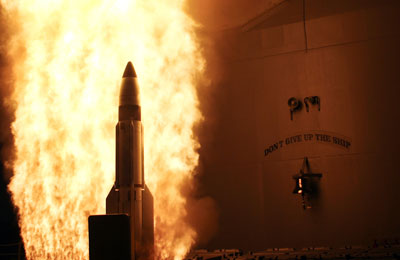Letters: wrapping up the USA 193 debateby Yousaf Butt and Andrew Higgins
|
| Simply put, the official scenario provided by NASA and DoD officials, that the hydrazine tank would likely have reached the ground intact, cannot be discounted lightly. |
However, even if we grant for the sake of discussion that the frozen or liquid hydrazine did begin to burn, the burning rate of hydrazine (indeed, of all liquid and solid propellants) is very sensitive to the surrounding gas pressure. This is because it is necessary for the burning propellant vapor to heat up and vaporize the unreacted propellant adjacent to it in order for a flame to propagate. The higher the pressure, the more burning vapor is available to heat the propellant. For most propellants, including hydrazine, the burn rate (that is, how fast the flame spreads into the fuel) is roughly proportional to the gas pressure. Under the pressurized conditions of a liquid rocket engine combustion chamber, hydrazine can burn quickly. For hydrazine at atmospheric pressure, however, the burn rate is only 0.2 to 0.3 mm/s, according to decades-old studies. At altitudes above 30 kilometers, where the ambient pressure is less than 1 kPa, we can extrapolate the burn rate of hydrazine to a value of less than 0.002 mm/s. It is doubtful, however, that flame propagation into liquid or frozen hydrazine can be observed at all with such a low flame speed. Indeed, a thorough review of the literature on hydrazine shows that it is unable to burn at pressure much below atmospheric under any circumstances.
Finally, note that even if the hydrazine in the tank was burning at a rate of 0.2 mm/s (as it does at atmospheric pressure), it would have taken about an hour to consume the hydrazine onboard USA 193, while the actual reentry would only have lasted a few minutes at most. Thus, the hydrazine could not have been consumed by the mechanism Yousaf Butt describes.
Yousaf Butt also makes the statement:
Lastly, the tank would have been expected to undergo roughly 25g’s of peak deceleration during re-entry—it may be somewhat more or less depending on the unknown initial angle of incidence. As some fraction of the hydrazine will have melted by the time of this peak deceleration, the smaller footprint of the remaining frozen hydrazine on the tank will likely dynamically stress the thin-wall tank beyond its design loads. Think: mixing a martini in an aluminum foil bag!
The deceleration of a reentering vehicle is indeed dependent on the angle of reentry. For a naturally decaying satellite such as USA 193, the angle of entry is very nearly zero. A classic study done by Dean Chapman of NACA in 1958 showed that the g-loading on a body reentering from natural decay is limited to about 8 g’s, independent of the details of the body. Indeed, in more detailed computer simulations of the reentry of the USA 193 satellite performed independently by Geoff Forden of MIT and myself, we have found that the maximum deceleration of the tank would have been about 8 to 10 g’s. This is similar to the g-loading the fully fueled tank is designed to withstand upon launch. Thus, it is unlikely that a similar loading would have destroyed the tank on reentry, even if the contents of the tank were of mixed phase.
Simply put, the official scenario provided by NASA and DoD officials, that the hydrazine tank would likely have reached the ground intact, cannot be discounted lightly. The intercept of USA 193 may have been inexplicable in terms of a cost vs. benefit analysis or even repugnant from a policy perspective. Indeed, it is possible that factors other than concern of the hydrazine tank impacting a populated area contributed to the decision to intercept the satellite with a missile. Accusing public officials, such as the current NASA administrator, of promoting an outrageously concocted story (i.e., that the hydrazine tank just might survive to hit the ground) in order to justify the intercept is not very productive, either. In my experience, conspiratorial thinking is rarely an accurate tool in understanding human behavior.
Andrew Higgins
The recent revelation that the Department of Defense models did not predict a hydrazine explosion during the interception of USA-193’s hydrazine fuel tank raises grave concerns over the fidelity of their reentry models in general. Specifically, was the assertion that the hydrazine would have survived the fiery reentry based on similar models?
| It would serve NASA/NRO/DoD well to immediately publicize the unclassified portions of their studies so that the public can ascertain whether the putative public health concern of the hydrazine surviving reentry was indeed well-founded. |
The US Navy Aegis air and space defense manager is quoted as saying that “We didn’t predict an explosion [after the interception], but the hydrazine tank did burn for tens of seconds.” This is exactly the type of behavior one would expect from a chemical deflagration or thermal runaway of the hydrazine decomposition reactions.
It is certainly possible that a similar honest mistake was also made in modeling the physical chemistry of the hydrazine during reentry but, if so, it is still an inexcusable shortcoming given the great expense and very negative international and policy repercussions of the ASAT interception.
It would serve NASA/NRO/DoD well to immediately publicize the unclassified portions of their studies so that the US public can ascertain whether the putative public health concern of the hydrazine surviving reentry was indeed well-founded. As technical details of hydrazine tanks are freely available online, it is difficult to comprehend what is so classified about these studies.
Yousaf Butt
